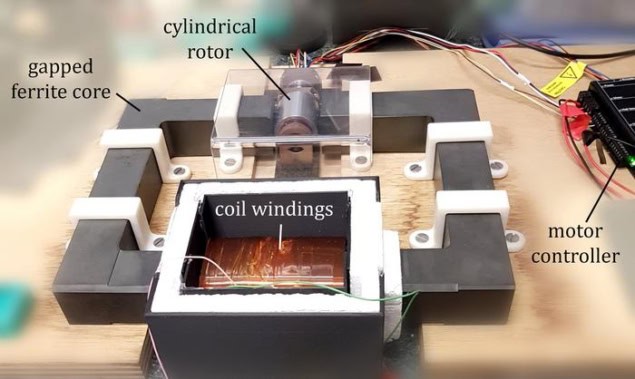
Physicists have observed the Zel’dovich effect in an electromagnetic system – something that was thought to be incredibly difficult to do until now. This observation, in a simplified induction generator, suggests that the effect could in fact be quite fundamental in nature.
In 1971, the Russian physicist Yakov Zel’dovich predicted that electromagnetic waves scattered by a rotating metallic cylinder should be amplified by gaining mechanical rotational energy from the cylinder. The effect, explains Marion Cromb of the University of Southampton, works as follows: waves with angular momentum – or twist – that would usually be absorbed by an object, instead become amplified by that object. However, this amplification only occurs if a specific condition is met: namely, that the object is rotating at an angular velocity that’s higher than the frequency of the incoming waves divided by the wave angular momentum number. In this specific electromagnetic experiment, this number was 1, due to spin angular momentum, but it can be larger.
In previous work, Cromb and colleagues tested this theory in sound waves, but until now, it had never been proven with electromagnetic waves.
Spin component is amplified
In their new experiments, which are detailed in Nature Communications, the researchers used a gapped inductor to induce a magnetic field that oscillates at an AC frequency around a smooth cylinder made of aluminium. The gapped inductor comprises an AC current-carrying wire coiled around an iron ring with a gap in it. “This oscillating field is an easy way to create the sum of two spinning fields in opposite directions,” explains Cromb. “When the cylinder rotates faster than the field frequency, it thus amplifies the spin component rotating in the same direction.”
The cylinder acts as a resistor in the circuit when it is not moving, but as it rotates, its resistance decreases. As the rotation speed increases, after the Zel’dovich condition has been met, the resistance becomes negative. “We measured the power in the circuit at different rotation speeds and observed that it was indeed amplified once the cylinder span fast enough,” says Cromb.
Until now, it was thought that observing the Zel’dovich effect in an electromagnetic system would not be possible. This was because, in Zel’dovich’s predictions, the condition for amplification (while simple in description), would only be possible if the cylinder was rotating at speeds close to the speed of light. “Any slower, and the effect would be too small to be seen,” Cromb adds.
Once they had demonstrated the Zel’dovich effect with sound waves, the Southampton University scientists – together with their theory colleagues at the University of Glasgow and IFN Trento – realized that they could overcome some of the limitations of Zel’dovich’s example while still testing the amplification condition. “The actual experimental set-up is surprisingly simple,” Cromb tells Physics World.
Observing the effect on a quantum level?
Knowing that this effect is present in different physical systems, both in acoustics and now in electromagnetic circuits, suggests that it is quite fundamental in nature, Cromb says. And seeing it in an electromagnetic system means that the team might now be able to observe the effect on a quantum level. “This would be a fascinating test of how quantum mechanics, thermodynamics and (rotational) motion all work together.”

Gravitational waves could reveal ultralight bosons lurking near black holes
Looking forward, the researchers will now attempt to improve their experimental set-up. At present, it relies on an oscillating magnetic field that contains equal co-rotating and counter-rotating spin components. Only one of these should be Zel’dovich-amplified by the rotating cylinder (the co-rotating component) while the other is only ever absorbed, explains Cromb. “Ideally, we want to switch to a rotating magnetic field so we can confirm that it is only when the field and cylinder rotate in the same direction that the amplification occurs. This would mean that the whole field can be amplified and not just part of it.”
The team has already made some progress in this direction by switching to using a cylindrical stator (the stationary part), not just because it can create such a rotating magnetic field, but also because it fits snugly around the cylinder and thus interacts more strongly with it. This should increase the size of the Zel’dovich effect so it can be more easily measured.
“We hope that these improvements will help us also show a situation akin to a ‘black hole bomb’ where the Zel’dovich amplification gets reflected back efficiently enough to create a positive feedback loop, and the power in the circuit skyrockets exponentially,” says Cromb.



